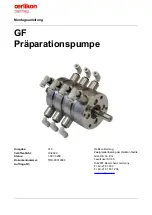
SHERPA SHW
Sanitary water heat pump
24
The logic starts to calculate t2 only when T3 has reached TS3.
It’s possible to set the interval between the disinfection cycles (parameter 21).
If the unit is “OFF”(and also if ON/OFF contact is opened), the disinfection starts with the same logic of “ON” unit.
If the unit is disconnected from the power supply, the disinfection cycle will not occure. If the unit is left without
power supply for longtime, DO NOT use the water contained inside. It is recommended to emplty the tank and the
water contained inside the pipes of the DHW system. It is also recommended that you let the water flowing for
enough time across the pipes not only for renewing all the water but also for washing the pipes themselves. This
required "washing" time is inversely proportional to the temperature of the water flowing in the pipes.
After cleaning and renewing all the water contained inside the unit and in the pipes of the system, you should
proceed with a disinfection.
The disinfection cycle occurs only inside the water tank. Therefore, it’s recommended to perform a recirculation of
the water system especially for disinfecting all the contained water. If cannot be possible, according to the
preceding warning, it is recommended to let the water system to flow for a enough for cleaning the pipes and
renewing the water.
If the parameter 5 (t2) is set to be 0, the disinfection function is disabled. Such operation is strictly
unrecommended; the manufacturer declines any responsibility for the data caused by a lack or incorrect unit
disinfection. If you desire to disable the disinfection cycle, you should ask the maintainer about the consequences
that may arise from this operation
It is strictly forbiden to change the default value of parameter 4. The parameters 4 and 5 control the anti-
legionella cycle (temperature versus time). We recommend to respect the above guidelines, if you want to change
them. Please remember that to keep the temperature of the tank water between 55-60°C in order to inhibit the
bacterial proliferation (see Annex 13 of the guidelines mentioned above).
The parameter 21 acts on the frequency of disinfection cycles. It must be properly set according to the storage
temperature of the tank and the frequencies of DHW utilization. Higher frequency of the disinfection cycle, results
in a lower possibilities of bacteria contact.
The stagnant water allows Legionella bacteria to grow. For this reason it is necessary to properly valuate the
frequency of the disinfection cycle according to its own uses.
The plant designer must keep in mind the legionella risk and should adopt all the measures for prevention and
control of water.
11.4.6
Electrical heater
E-heater turned ON or OFF condition 1:
(when the unit is turned on, and the E-heater button on the control panel hasn’t been turned on manually)
1.
ON: when the tank water setting temperature TS1 (parameter 0) is bigger than the working limit that is expressed in
Paragraph 17, the lower tank temperature T2 has reached this limit and the upper tank temperature T3 ≤ TS1-3°C;
OFF: when the upper tank temperature T3 reaches the setting temperature TS1+1°C.
2.
ON
:
when the ambient temperature ≤ -10°C or > 44°C;
OFF
:
when the ambient temperature ≥ -8°C or < 42°C.
3.
ON
:
when there is high pressure or low pressure protection for 3 times in 30 min;
OFF
:
when the third time pressure protection occurs, the error code will be displayed, and this protection can not be
recovered unless powering off the supply. So the E-heater keeps running to reach the setting temperature, then it is
switched off.
4.
ON
:
when in defrosting (only if the parameter 20 is set to 1=on) or disinfection;
OFF
:
when exit defrosting or disinfection.
The integration function of the electrical heater that is described at point 1 of condition 1 can be disabled by
parameter 32 (see Paragraph 11.5).
E-heater turned ON or OFF condition 2:
(when the unit is turned on, and the E-heater button on the control panel has been turned on manually)
1.
ON
:
compressor runtime exceeds the E-heater delay time (parameter 3), and the upper tank water temperature T3≤TS2-
3°C;
OFF
:
upper tank water temperature T3 ≥ TS2+1°C.













































